Three years ago, when I lived in Madrid, I experienced dramatic culture shock—but it wasn’t the large amount of ham in my diet or the frank attitudes of Madrileños that caught me off-guard. Instead it was the young women in provocative clothing that I saw in broad daylight when I walked the off-shoots of Gran Vía. I knew sex trafficking was a lucrative business in Europe, but the flagrance and simplicity of it alarmed me.
Spain does not have a good record when it comes to preventing and prosecuting human trafficking. It took the country until 2010 to ban the humiliating and degrading human rights violation, and the practice was only banned after extensive pressure from the European Union. 5,675 victims of sexual exploitation and forced unpaid labor were identified in the country between 2012 and 2016, according to the Spanish Interior Ministry’s Counter-Terrorism and Organized Crime Intelligence Center. Many of the victims, usually young women from Eastern Europe, become trapped by trafficking rings because they do not speak Spanish or have no understanding of local laws. Even though Spain was the first European country to join the United Nations Office on Drugs and Crime’ Blue Heart Campaign, an initiative to combat trafficking of persons, it is still the country with one of the highest numbers of victims on the whole continent.
It comes as little surprise, then, that Spain has refused to confront the human trafficking crimes taking place every day between their exclaves of Cueta and Melilla and the towns across the border in Morocco—or that another form of trafficking is taking place 400 miles south of Madrid.
Each day, thousands of single mothers and divorced women carry back-breaking amounts of Spanish goods across the frontier from Cueta and Melilla to Morocco. Usually referred to as “mule women,” or porteadoras, they often carry up to 200 pounds worth of electronics, kitchen equipment, clothing, gear and other commercial items miles on foot. As many as 15,000 women have been estimated to participate in the cross-border trade, which many activists have described as an “organized smuggling racket” because the women are forced to report to powerful bosses in warehouses before and after taking the journey. They usually always work more than nine hours a day. They are never guaranteed 12 hours of rest time. Some of the women are under 18 years of age. And they face harassment, abuse and violence on the trek—with little or no protection.
The work is obviously cruel, and it ignores Spanish labor laws. There have been repeated denunciations by rights groups of the harassment of the women by Spanish and Moroccan police forces—but why would either government be incentivized to do anything when the informal trade is estimated to be worth more than 300 million euros? Corruption among border authorities even allows the bags to be carried through duty-free because they aren’t being transported by vehicles.
Earlier this year, two mule women were trampled to death when trying to cross the border with their packages. They are not the first. In 2016, at least four women were trampled to death in the rush across the immigration station, and for years, headlines have been decrying the poor treatment of the women and the way they get trapped conveying goods for powerful local gangs and businesses. In 2013, BBC ran a story about the heavy-lifting; as recently as late last year, major news outlets like Voice of America were publishing pieces about the women scratching a living as porteadoras.
The problem is becoming more urgent. With dramatically rising unemployment rates in Morocco, “mule women” are facing competition from more women seeking nontraditional ways to earn money—and men. Usually capable of carrying more at faster rates, men are edging women out, and they are putting increased pressure on the customs crossings. The pressure has created an over-busy immigration station where trampling and aggression is even more likely, and the Spanish government recently made the situation worse by limiting the number of people that can pass through the border, creating clogged lines to enter Cueta and Melilla. With the status of Gibraltar up in the air due to Brexit negotiations, it might not be surprising if a defensive Spain tightens their hold on Cueta and Melilla even further, thereby extremely limiting the traffic between the exclaves and Morocco.
The solution here is not ending the foot traffic between the exclaves and Morocco—instead, the Spanish and Moroccan governments need to work together to better regulate such trade. There needs to be more accountability at the border so that women do not risk death when they travel from one country to the next—and there needs to be better oversight to ensure the women are paid fairly by businesses on each side of the crossing.
Until then, these women will continue to carry the literal burden of inequality—walking on in hopes that someday, lawmakers may finally let them stop to rest.





